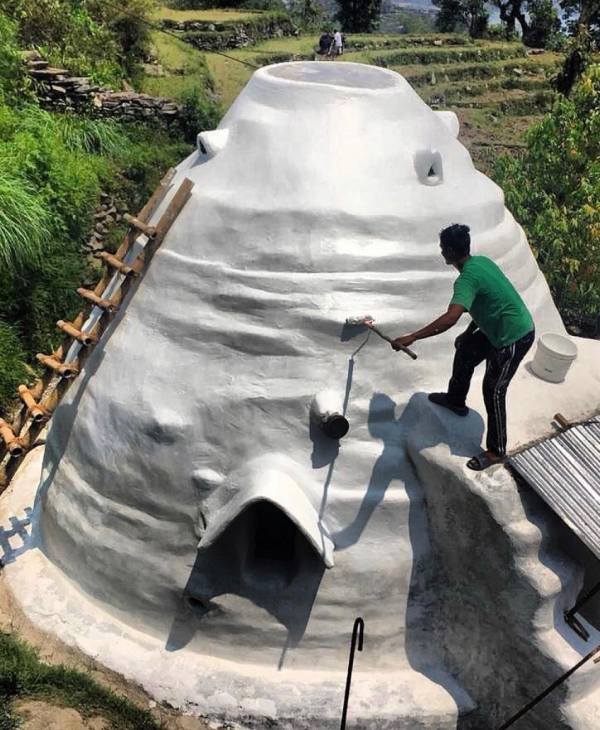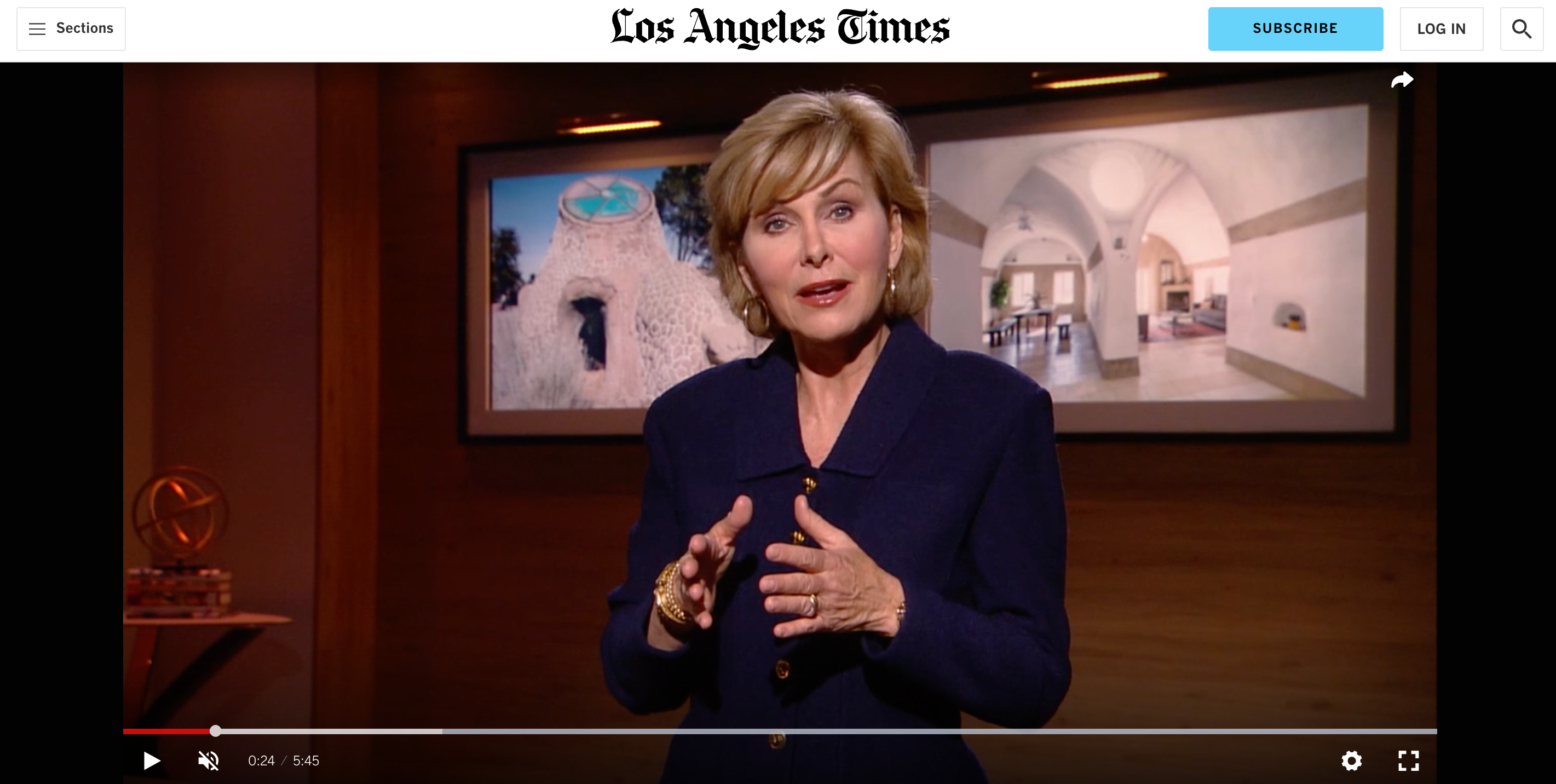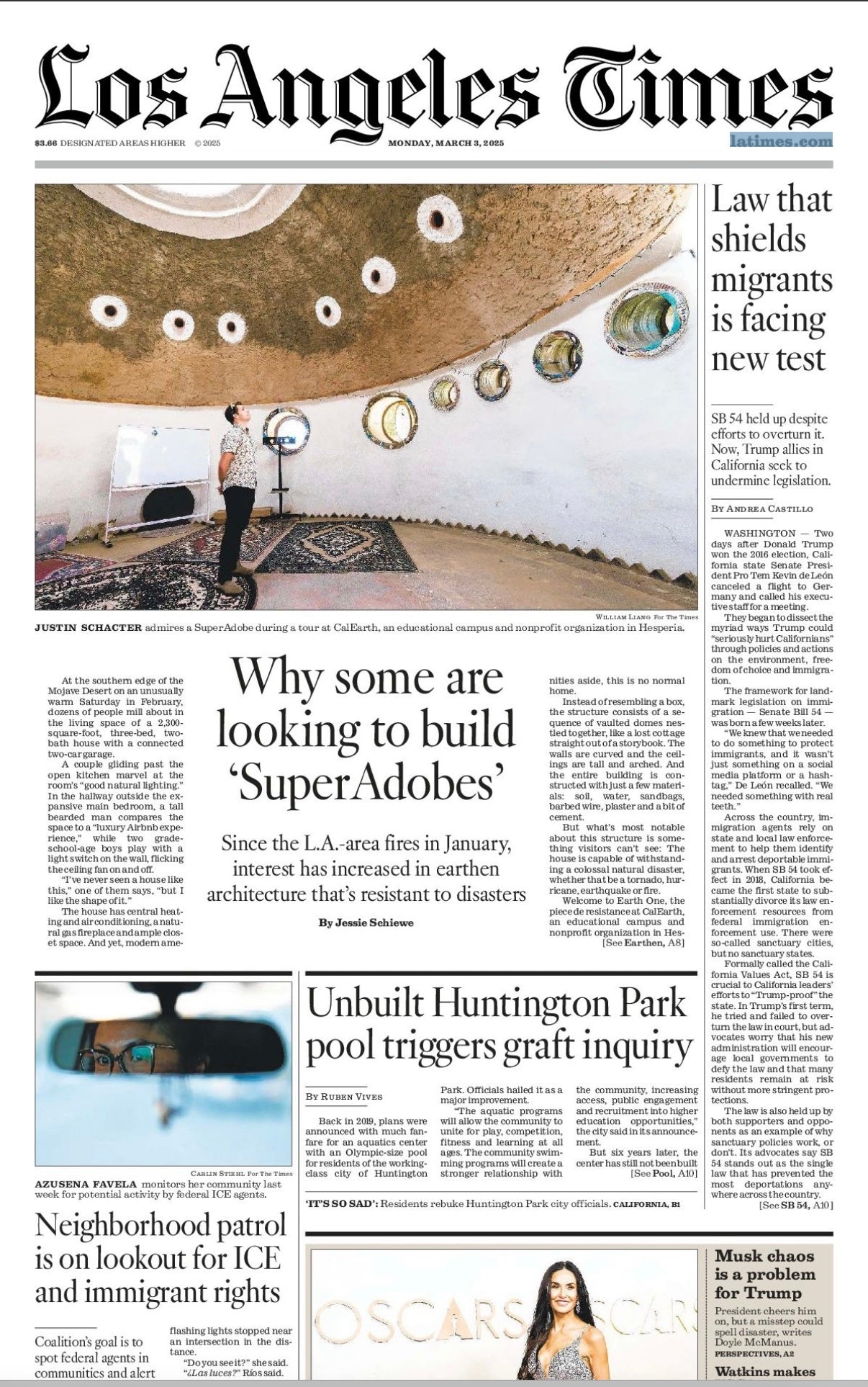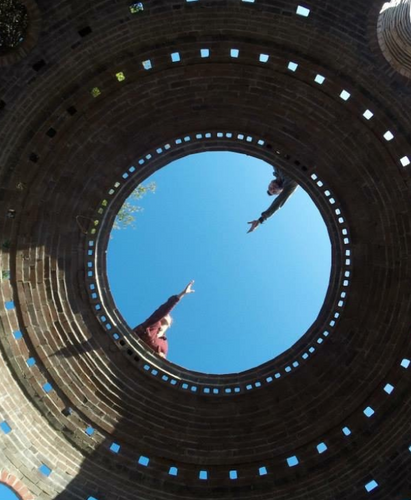A long-term apprentice, Ben began his SuperAdobe journey at CalEarth and then traveled to Nepal to build. Learn more about his adventure below!
How did you first hear about CalEarth?
It has been nearly a decade since I first heard about CalEarth. A friend mentioned SuperAdobe and I looked it up online. I clicked on the CalEarth website and was immediately attracted to the curvilinear aesthetics of Khalili’s designs. The building techniques and humanitarian efforts spoke to my ideals yet being young and caught in routine, it wouldn’t be until years later that I stepped foot onto the CalEarth campus. The long-term apprenticeship often crossed my mind over the course of those years. Finally, after attending an open house, I was inspired to officially begin my SuperAdobe journey.
What did you learn during you apprenticeship at CalEarth and what projects did you assist with?
Within the first days of the apprenticeship I learned the basic concepts and techniques while building a 6’ dome with the core curriculum workshop. From landscape applications to design, windows and doors, basic plumbing and electric, plasters and finishes, the apprenticeship offered a wealth of knowledge and experience in 10 short weeks. My group completed another 9’ dome with a 4.5’ apse, a clay plaster and installed a door constructed from scratch. We contributed to various other projects from the great CalEarth perimeter wall to campus upkeep, garden additions, plaster, paint and general dome maintenance as well as assisting with weekend workshops.

What surprised you the most while at CalEarth?
What surprised me the most while at CalEarth and what continues to surprise me is why this incredibly beautiful, simple, effective, efficient, economical, seismic and fire resistant building technique is not more widely known and employed. CalEarth brings a logical solution to many of the issues surrounding the global housing crises. So the surprise is why we continue to plunder our recourses, producing chemically saturated, high cost, high impact materials while such a viable alternative is literally under our noses.
What do you wish people knew about CalEarth?
I wish for more people to simply know that CalEarth exists. I hope for people to be empowered by the techniques and knowledge that the institute offers, and to know that we can build our own low impact, healthy, wholesome homes.
Why do you choose to build using the SuperAdobe method?
I choose this method because I understand it’s structural integrity and it excites me to have creative freedom and work with organic design principles. I enjoy the process of working with community hands on and learning the artistic nuances and subtleties that present themselves during the build. I choose this method because I believe in the principles behind the structures and I want to contribute to less energy consumptive development practices. On a more personal level, as a living, breathing, animated, human form of dirt, it feels natural and fuels an instinctual drive for me to form a home from the same elements from which I am created.

What brought you to Nepal?
I have long had an interest in the majesty of Nepal, and having the opportunity to build a dome there sealed the deal. My good friend, Hamilton Pevec, who works with my gardening and landscaping business, Awesome Blossoms lives part-time in Nepal with his wife and child. He was living in Nepal when the 2015 earthquake hit and became deeply involved with the aid relief and reconstruction process. At that time he researched the possibility of using earth-bag construction for rebuilding in the villages. Yet, having no hands-on experience with the techniques, they chose to rebuild from rubble using earthquake resilient modifications like banding, cap rings, thru stones, and vertical rebar reinforcements. That can all be seen in his new documentary film “Guerrilla Aid,” a story about the front lines of aid relief during the aftermath of a major disaster.
His interest in SuperAdobe didn’t fade, and after myself and fellow colleague and friend, Chris Ford attended the CalEarth apprentice program, Hamilton took the opportunity to utilize our new found skills and learn the techniques to build his own dome. Together, we traveled to Nepal along with another friend, James Gorman and the adventure began.

Talk about the dome you built in Nepal and what it will be used for?
We built a 15’ dome on Hamilton’s land just outside Pokhara where he, his wife and her brother run a yoga retreat center called Himalayan Yogini. The dome will be a meditation and singing bowl space before it is finished as a home for Hamilton and his family. Building in Nepal offered us many unique challenges and learning opportunities. Reworking our expectations of time management and labor, as well as tool and material availability was the first obstacle. Coming from the USA, where you can pick up anything you want from multiple locations in nearly any town in the country, it was a wake up call to be faced with fashioning our own tool handles, building our pole compass from bamboo, wire and duct tape, constructing forms with handsaws and low quality nails, building bamboo ladders, lashed with coconut rope and spending days searching for simple “common” materials in town. Furthermore, manual excavation through many feet of ancient rice terrace proved to be a far greater challenge than we expected. This process took around two weeks and we encountered many large boulders along the way. Luckily by that point our Nepali workforce had shown up to literally crush the boulders with sledge hammers while working in their flip flops. Being that we were building in a seismically active zone that is pounded with over 130” of monsoon rain per year, we decided to stabilize our bag mix with 20% cement for the foundation, 15% to buttress height and then 9% for the rest of the dome. This added a great deal of labor to our process but lent us some piece of mind for the dome’s safety and longevity.
How long did it take to build the dome and who helped with your build?
In total, it took us just over a month, from ground breaking to completing the bag work. There is absolutely no way we could have accomplished that without the incredible help from the Nepali locals who showed up to help us. Initially we had 5 guys but after the first couple weeks one guy had to go back to his village. So for the remaining couple weeks we had 4 Nepali’s and 4 of us Americans.

Did you incorporate any local traditional design into the dome?
I wouldn’t say we incorporated any traditional Nepali design into the build, other than using the local soil and orienting the dome to face the sacred Mt Panchase. We did however have a traditional Buddhist Puja performed before we started our foundation courses. The family hopes to incorporate some traditional clay plaster and paint for the interior and certainly with the resources we had, and our amazing work force it was all built in “Nepali style.”
What is your hope for the future of CalEarth?
I hope that SuperAdobe is granted approval with the international code counsel, making it an official, permitted residential building alternative and that CalEarth may continue to grow and flourish as the incredible learning center that it is, bringing this technology to the people for generations to come. I envision the campus as a hub for the growing SuperAdobe industry, producing professionals worldwide, as it has done for years. I believe that our ever-growing population is in demand of lower input housing and development. I see CalEarth as a major player, ushering this technology into the mainstream.
Do you plan to stay involved with CalEarth moving forward? How?
Absolutely! In whatever capacity possible! I plan to continue sharing my own knowledge, passion and experience with others, promoting the institute and taking the opportunity to build with this technology whenever possible. I am always open to whatever opportunity I can take to work with CalEarth.
If you could describe the SuperAdobe method of building in one word, what would it be?
Integrative




